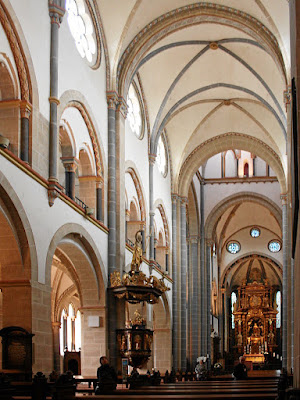Basilicas in India—Kerala
I blogged about the following basilica on July 2, 2021.
- Cathedral Basilica of St. Mary (Syro-Malabar Rite) in Ernakulam.
Cathedral Basilica of the Holy Cross, Kochi
Declared a minor basilica by Pope John Paul II in 1984.
The Basilica is the Cathedral for the Diocese of Cochin. The Portuguese built the original church in the early 16th Century, and this raised to cathedral status with the erection of the Diocese of Cochin in 1558—one of the first dioceses in India. The Dutch used the church as a storehouse after conquering Cochin in 1663. The British demolished the building in 1795. The current Gothic church was built between 1887 and 1905.
All pictures are from Wikipedia.
Basilica of Our Lady of Sorrows, Trichur
Declared a minor basilica by Pope John Paul II in 1992.
The Gothic church is said to be the tallest church in India. It covers 25,000 square feet and its central tower rise to 260 feet. It features 11 altars. The Syro-Malabar church was built in 1929.
The first picture is from a local source and the others are from Wikipedia.
National Shrine Basilica of Our Lady of Ransom, Vallarpadam
Declared a minor basilica by Pope John Paul II in 2004.
A picture of the Blessed Virgin Mary and the Infant Jesus was brought here in 1524 by the Portuguese under the leadership of Vasco de Gama. A church was built, but it was destroyed by a flood in 1676 but was soon replaced by the current brick structure. After a miracle is said to have occurred due to Our Lady’s intercession, pilgrims began coming here and today about 5 million people come every year.
The first two pictures are from local sources and the last two are from Wikipedia.
Basilica of St. Mary, Queen of Peace, Trivandrum
Declared a minor basilica by Pope Benedict XVI in 2008.
A Syro-Malankar parish was started here in 1933 in a former movie theater. It was replaced by the current Indian Neo-Gothic church in 1991.
From a local source and Wikipedia.
Basilica of St. George, Angamaly
Declared a minor basilica by Pope Benedict XVI in 2009.
This Syro-Malabar church opened in 2006 to replace an older church. It contains 24,000 square feet of floor space.
From a local source and Wikipedia.
Basilica of St. Andrew, Arthunkal
Declared a minor basilica by Pope Benedict XVI in 2010.
The church was originally built by the Portuguese in the 16th Century and was rebuilt in the 17th Century. Although dedicated to St. Andrew, the church received a statue of St. Sabastian in 1647, and it has since become a major shrine honoring St. Sabastian.
The first picture is from Expedia and the second from Wikipedia.
Basilica of Our Lady of Snow, Pallippuram
Declared a minor basilica by Pope Benedict XVI in 2012.
The Portuguese built this church in 1507 although it was renovated in 1931 and 2006. The church gets its name from a miracle. A Muslim army had invaded the area in the 18th Century and destroyed many Christian and Hindu places of worship. Locals took refuge in the church and prayed to Our Lady for her intervention. Snow started falling and the Muslims could no longer see it thinking the area was just part of the sea. A 500-year-old painting from Portugal is on the altar.
The first two pictures are from local sources and the last two are from Wikipedia.
Basilica of St. Mary, Champakulum
Declared a minor basilica by Pope Francis in 2016.
This Syro-Malabar church dates to around 427 although it has been rebuilt many times. A rock cross dates to 1151. It was originally under the jurisdiction of another church founded by St. Thomas the Apostle.
The first picture is from a local source and the other two are from Wikipedia.
Basilica of Our Lady of Mt. Carmel and St. Joseph, Varapuzha
Declared a minor basilica by Pope Francis in 2020.
The church was built in 1673 and once served as an archdiocesan cathedral. The Venerable Mother Eliswa (1831–1913), the Mother Foundress of the first indigenous Carmelite congregations, is buried here.
The first three pictures are from Wikipedia and the last is from YouTube.










































































